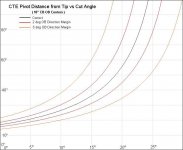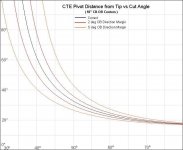So you admit the test you posted and whined loudly about nobody accepting was in fact meaningless?
pj
chgo
You're the one who mouthed-off that you'd like to see it. Well, ya saw it....Now you say it's meaningless.
make up your mind
So you admit the test you posted and whined loudly about nobody accepting was in fact meaningless?
pj
chgo
...
In fact, what would be much more impressive would be the ability to deliver the OB to a point on the table that could not easily be inferred from pocket position.
I always said it was meaningless. You're the one changing your mind. Is it meaningful as you claimed when you posted it, or is it meaningless as you claim now because nobody else did it?Spidey confuses himself:
Now you say it's meaningless.
make up your mind
Okay, I think I may have a way to settle all the disputes.
Maniac
...would be irrelevant. How well it works isn't the question we always wrestle with, the question is how it works and why nobody can explain it.maniac:
a true determination of what aiming method is best
OK Mike, here is the answer again "three alignments, thick-thin-thinner. The qball and ob are always in different places so there are many angles however the 3 alignments will cover these many angles."
I thought Dave shot well in that video. However, there is a valid point to "landmarks" around the room, as well as the table itself, to help obtain that original pocket reference. For instance, the stainless steel "catcher's mitt" on Dave's table's pockets are readily visible even with all the "horizontal" obstructions (e.g. cardboard). Just aim for the center of the catcher's mitt, and the pocket's right there.
IMHO, I think the closest anyone's come to a truly "blinded pocket view" is pool101. He just made one mistake with that windshield sunscreen -- he mounted it upside-down so the rearview mirror cutout is towards the table surface, covered it up with a sheet of paper, and placed the object ball directly in front of it (i.e. it itself served as a pocket marker/locator). Doesn't matter that the cue ball was moved around to simulate various cut angles; the fact is that all he needed to do was to cut the object ball to split the center of the sheet of paper, and it was headed towards the pocket. I think if this was done with the windshield sunscreen mounted right side up (i.e. the rearview mirror cutout on top), it would've been a more true "blind/obfuscated pocket view" test.
Speaking of all these blind/obfuscated pocket view tests, someone remind me again why we're doing them, and what they have to do with explaining the geometry/accuracy behind CTE? I got lost on that one...
-Sean
OK Mike, here is the answer again "three alignments, thick-thin-thinner. The qball and ob are always in different places so there are many angles however the 3 alignments will cover these many angles."
Per your request. I think this should do.
Again I am not trying to disprove any system... just show that the video tests as done are not a valid test...
http://www.youtube.com/watch?v=8OD2T4mh9m8
Mark
I don't know what that means. Would you please elaborate?
Maybe its me but it looked as though you could see through your obstacle, not very clear but still see the outline of the table.
Are you shooting by feel ?
Maybe its me but it looked as though you could see through your obstacle, not very clear but still see the outline of the table.
Are you shooting by feel ?
Looks that way to me also
CTE works and WE know it.
THAT is all that matters, I use it on every
shot, break included .
I'm not "You Guys," and if you think there's something important that I missed, the polite thing is to point me to it.
OK Mike, here is the answer again "three alignments, thick-thin-thinner. The qball and ob are always in different places so there are many angles however the 3 alignments will cover these many angles."
LOL. Now all you have to do is tell us what that means.
pj <- like talking to Martians
chgo
Couldn't agree more with your post.
Ok, bear with me.....
If someone can come up with something mathematical that can explain it, that would be nice, (how pivot changes the shot by X degrees, etc. etc.) but i'm not keeping my fingers crossed.
Otherwise, i will continue to believe that CTE doesn't have a factual basis for the results that people swear by.


So if it a reflective image I am seeing are you using that to know where the pocket is, sorta like the mirror image for banking?At 2:05 you can see the nine ball on the left side of the screen..
from 2:07 to 2:15 you cannot see it at 2:16 you can start to see it, at 2:18 there it is plain as day.....
this is why I knew I should not have posted..
I never said it does not work....... and I am glad it works for you.
I want to see the video and see if it helps me..
I do not use everything I have seen because some things I do not get, or I find something I like better....
I think everyone is searching and as Tim the tool man says "You Can Never have too many Tools!" Grunt!! Grunt!!! I don't know how to make a pig noise on here.*pig noise*
Mark
Per your request. I think this should do.
Again I am not trying to disprove any system... just show that the video tests as done are not a valid test...
http://www.youtube.com/watch?v=8OD2T4mh9m8
Mark